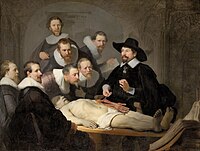
Photo from wikipedia
Most clinicians do not routinely remove bullets from patients with gunshot wounds to avoid the risks of surgical intervention. There are considered to be only a few medical indications for… Click to show full abstract
Most clinicians do not routinely remove bullets from patients with gunshot wounds to avoid the risks of surgical intervention. There are considered to be only a few medical indications for removing a bullet. In criminal investigations in which surgical intervention to recover a lodged bullet is not advocated, radiological images can provide important information on the type of ammunition used. In the last century, X-ray imaging has become a standard procedure to locate bullets that are lodged inside the body, and retained bullets are among the most frequently encountered metallic foreign bodies detected on X-ray imaging. The radiographic depiction of a bullet on the X-ray image can be used to classify a bullet according to its shape and size. For this purpose, magnification factors have to be considered, since the radiographic depiction of a bullet can be magnified compared to the actual size of the lodged bullet, depending on the distances from the X-ray tube focal spot to the X-ray film and to the bullet. Furthermore, an X-ray image allows only a twodimensional summation image representing the degree of X-ray absorption along the X-ray beam path. Thus, at least three orthogonal X-ray images are required for calibre calculations. Three-dimensional computed tomography (CT) data largely bypass these limitations, as an object can be rotated and aligned to any desired plane using multiplanar reconstructions (two-dimensional view) or volume renderings (three-dimensional view). Furthermore, CT data are increasingly available, as CT scanning is increasingly applied in emergency departments. Nevertheless, the opportunity of a virtual investigation of a lodged bullet by means of CT images is frequently not considered, since it is well known that metallic objects cause severe artefacts on CT. Thus, the image quality of a delineated bullet on standard CT differs greatly from the familiar detailed depiction of a bullet on planar X-ray images. However, special reconstructions that are provided by all main CT manufacturers still enable a very detailed depiction of metallic objects on CT and allow Hounsfield unit (HU) measurements of such radiopaque material.
Journal Title: Medicine, Science and the Law
Year Published: 2020
Link to full text (if available)
Share on Social Media: Sign Up to like & get
recommendations!